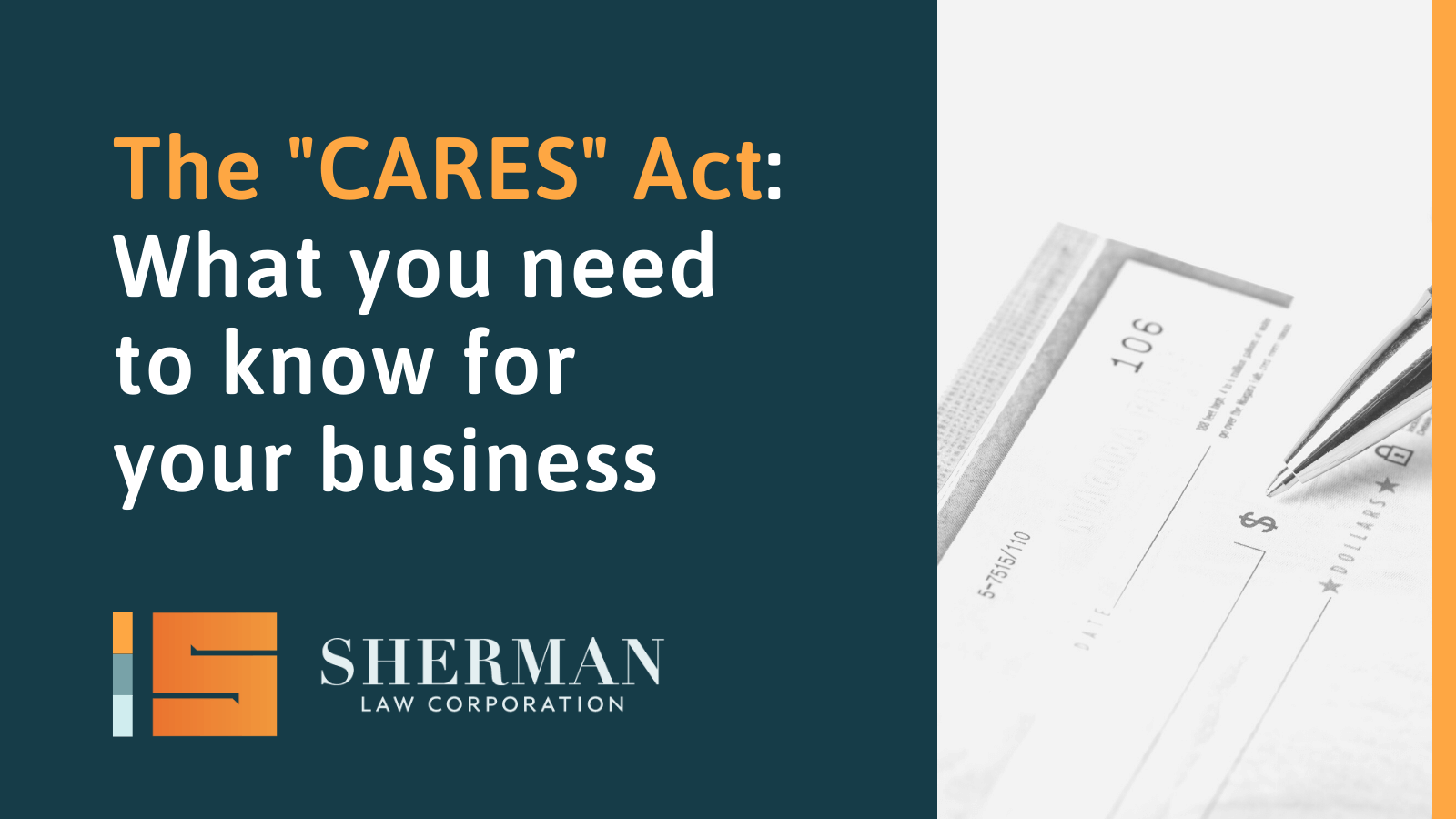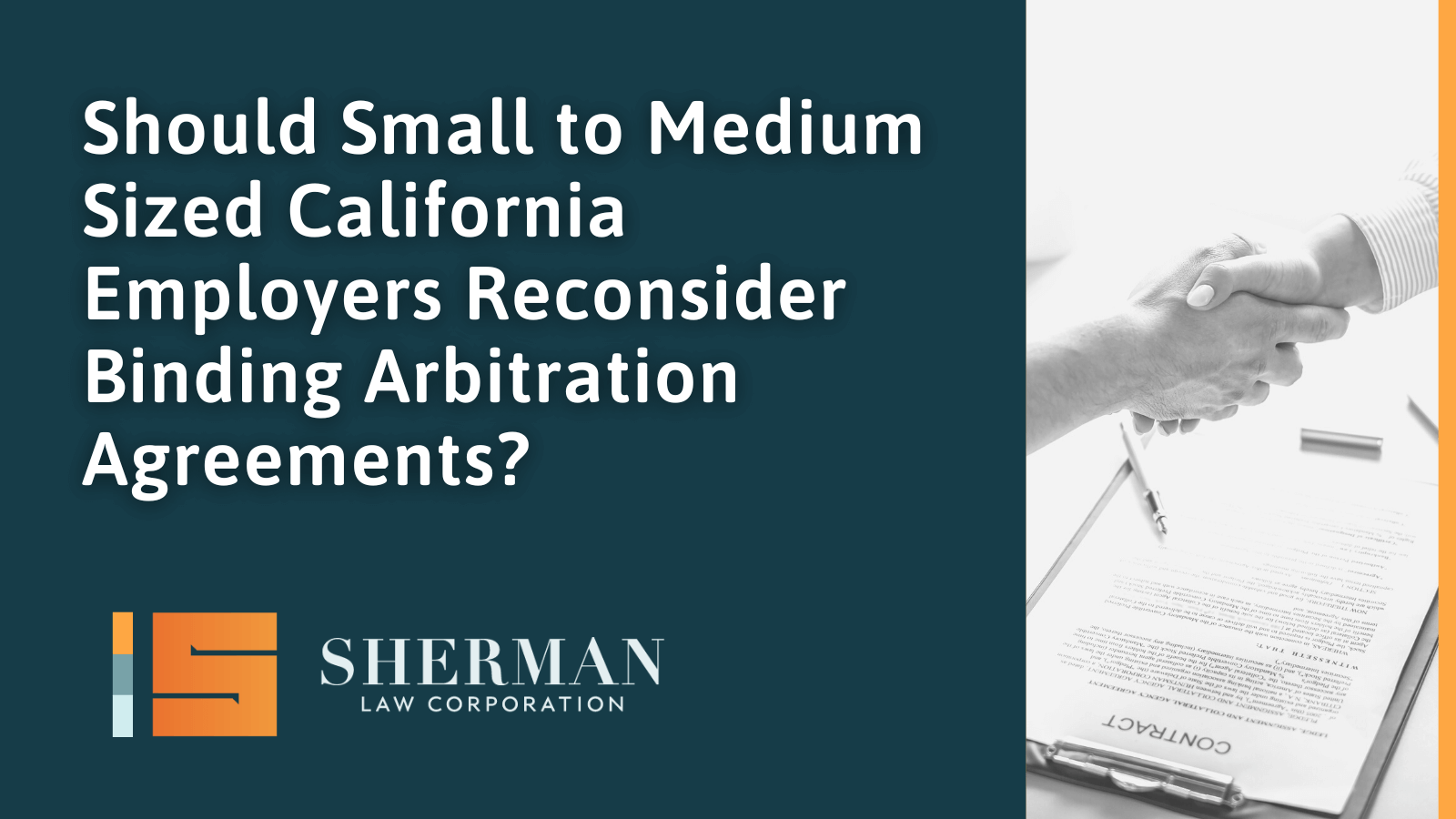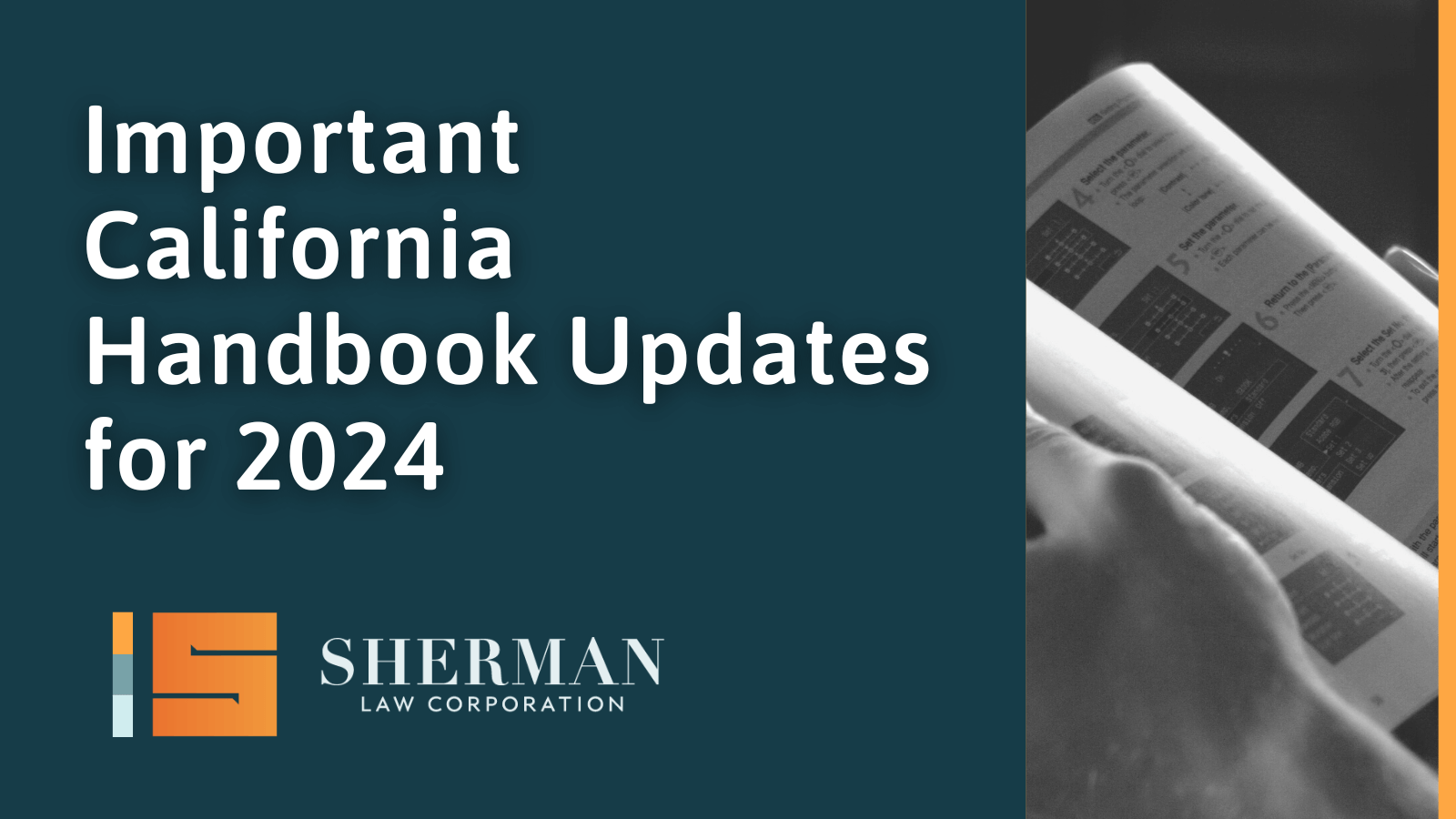
The Coronavirus Aid, Relief and Economic Security Act (more commonly referred to as the “CARES” Act) was signed into law on Friday, March 27, 2020.
But what does the CARES Act do for small businesses? For medium-sized ones? This blog will help you through the basics of the Act so that you and your business can know what to expect when it comes to grants, loans, taxes, sick leave, and more.
The Enactment of the (Federal) Coronavirus Aid, Relief and Economic Security Act (“CARES” Act)
On Friday, March 27, 2020, President Donald Trump signed The Coronavirus Aid, Relief and Economic Security Act (“CARES” Act) into law. The legislation is aimed at providing relief for individuals and companies impacted by the Coronavirus. I will set forth the key provisions of the bill for small to medium sized businesses.
A. Small Business Relief
The CARES Act provides emergency grants, forgivable loans and relief for existing loans to companies with 500 or fewer employees including:
- $10 billion to grants to cover immediate operating costs. Each grant may be in an amount up to $10,000.
- $350 billion dollars for the Small Business Administration to provide loans of up to $10 million dollars per business. Any portion of that loan that is used for payroll, to keep workers employed or to pay for rent, mortgage and existing debt is eligible for forgiveness, provided workers stay employed through the end of June 2020. (The Act requires the Small Business Administration to issue regulations on the forgiveness provisions within the next 30 days.)
- $17 billion dollars to cover six months of payments for small businesses that already have Small Business Administration Loans.
1. Grants
Grants available: Those who apply during the covered period for a Small Business Administration loan through the Small Business Act’s Disaster Loan Program because of COVID-19, may request up to a $10,000 advance, which does not have to be repaid even if the loan application is later denied. Advances are to be awarded within three days of making an application.
Eligibility for Grants: The CARES Act expands the Small Business Act’s Disaster Loan Program during the period of January 31, 2020 through December 31, 2020 to include businesses, cooperatives and employee stock ownership plans with 500 or fewer employees; sole proprietorships, with or without employees, and independent contractors; and tribal small business concerns.
Permissible uses of Grant Monies: Advances may be used to provide sick leave to employees who are unable to work due to the direct effect of COVID-19, maintaining payroll during business disruptions during slowdowns, meeting increased supply chain results, making rent or mortgage payments, and repaying debts that cannot be paid due to lost revenue. If a business that receives an advance is later approved for a loan under the Business Loan Program (detailed below), any loan forgiveness will be reduced by the advance.
Other Important Points: For loan applicants, the CARES Act waives rules related to personal guarantees on advances and loans of $200,000 or less for all applicants, waives the one year in business prior to the disaster requirement, waives any requirement that the applicant be unable to find credit elsewhere, and allows lenders to approve applicants solely on credit scores or alternative methods to determine an applicant’s ability to repay.
2. New Small Business Loans
Loan Coverage: For the covered period of February 15, 2020 to June 30, 2020, the CARES Act allows the Small Business Administration to provide 100% federally backed loans (either directly or in cooperation with the private sector), to eligible businesses to help pay operational costs, including: payroll (wages, commissions, cash), paid leave, severance payments, group health benefits, insurance premiums, retirement benefits, state and local payroll taxes, rent, mortgage, mortgage interest, utilities and interest on other debt obligations. The Act also permits loan proceeds to be used to cover up to $100,000 in one year is for sole proprietors, independent contractors, and commission based compensation.
Eligibility for Loans? Any business (including Tribal businesses), nonprofit, or veteran organization that employs not more than the greater of:
- 500 employees (whether employed full-time, part-time, or on other bases); or
- the Small Business Act’s definition of a qualifying business for that industry.
Hospitality Businesses are eligible for loans if they have more than one physical location and (i) employ 500 or fewer employees per location; and (ii) are in the “accommodation and food services” sector (Sector 72) under the North American Industry Classification System.
Certain Small Business Act regulations, such as those that affect the eligibility of hospitality, restaurants and franchises under 13 CFR 121.103, are waived for the covered period.
Sole proprietors, independent contractors, and self-employed individuals, who meet these definitions in the Families First Coronavirus Response Act, and satisfy the documentation requirements, are eligible to receive loans under this part of the Act.
Requirements for Loan: Certification from the applicant that:
- The loan is necessary to continue operations during the COVID-19 public health emergency;
- The loan will be used to retain workers, maintain payroll and make mortgage, lease, and utility payments;
- The applicant does not have any other application pending under the program for the same purpose;
- From February 15, 2020 until December 31, 2020, the applicant has not received duplicative amounts under the new Business Loan Program.
Loan Size Allowed: The maximum loan amount is the lesser of:
- $10 million;
- 2.5 times the average total monthly payroll costs incurred in the one year period before the loan is made plus the outstanding amount of a loan made under the Small Business Act’s Disaster Loan Program between January 31, 2020 and the date on which such loan may be refinanced as part of this new Business Loan Program (if the business is seasonal, the determination is calculated from the average monthly payroll cost for 12 weeks from February 15, 2019, or from March 1, 2019 to June 30, 2019); or
- For businesses that did not exist during February 15, 2019 to June 30, 2019, 2.5 times the average total monthly payroll payments from January 1, 2020 to February 29, 2020, plus the outstanding amount of any loan made under the Small Business Act’s Disaster Loan Program between January 31, 2020 and the date on which such loan may be refinanced under this Act.
Loan Forgiveness Terms: These loans are eligible for forgiveness and excluded from gross income in an amount equal to payroll costs (except wages above $100,000 per employee), rent, utilities, and mortgage interest payments in place prior to February 2020, but only for costs spent during an eight week period after the origination of the loan. (This is a major change from the prior bills which had an unlimited time period for full loan forgiveness)
The amount of the forgiveness for the loans will be reduced if the employer: (a) reduces its workforce during the eight week period compared to prior periods; or (b) reduces the salary or wages paid to an employee by more than 25% during the eight week period (compared to the most recent quarter).
Any reduction in the amount of loan forgiveness will be completely avoided if the employer re-hires all employees laid off (going back to February 15, 2020) or increased their previously reduced wages, no later than June 20, 2020. These provisions are designed to provide an incentive to employers to not lay off workers – or re-hire them- and instead utilize the loan amounts to pay payroll and other expenses (although only for an eight-week period).
How to Apply for Loan Forgiveness: Borrowers who want to seek loan forgiveness under this program must submit the following information to their lender:
- Documentation verifying full time employees on payroll and their tax rates;
- Documentation of costs/payments (mortgage, rent, utilities);
- Certification from a business representative that the documentation is true and correct and that forgiveness amounts requested were used to retain employees and make other forgiveness-eligible payments; and
- Any other documentation the Small Business Administration or lender may require.
Where to Apply for Loan Forgiveness: Lenders authorized to make loans under the Small Business Act’s current Business Loan Program are automatically approved to make and approve these loans and the Department of the Treasure may add more private sector lenders.
Other Important Terms Employers Need to Know: No collateral or personal guarantee is required for a loan. The interest rate is capped at 4%. There will be no subsidy recoupment fee associated with the loans and no prepayment penalty for any payments made. Additionally, the Small Business Administration has no recourse against any individual, shareholder, member or partner of an eligible loan recipient for non-payment, unless the individual uses the loan proceeds for unauthorized purposes. Loan amounts that are not forgiven will have a maximum maturity date of 10 years from the date the borrower applied for loan forgiveness.
Refinancing Prior SBA Loan Amounts: A loan made under the Small Business Act’s Disaster Loan Program on or after January 31, 2020, may be refinanced as part of a covered loan under this new Business Loan Program as soon as the new business loans are made available.
Qualifications for Loan: The CARES Act contains guidance to the Small Business Administration intended to ensure that processing and distribution of loans under the new Business Loan Program prioritizes small business concerns, entities underserved and rural markets (including veteran communities), small business concerns owned by socially and economically disadvantaged individuals, women, and businesses that have been operating for fewer than 2 years.
3. Other CARES Act Benefits to Small Businesses
The CARES Act also contains tax provisions that:
- affect whether loan proceeds are included in gross income for federal income tax purposes;
- provide employee retention tax credits; and
- postpone due dates for employer payroll tax deposits and self-employment taxes.
B. Loans to Mid-Size Businesses
Eligibility: mid-size business who employ 500 to 10,000 employees are eligible for direct loans under the Emergency Relief and Taxpayer protection portion of the CARES Act.
Requirements for Loan: Certification by the applicant of “good faith” requirements likely to occur on a form provided as part of the application for the loan and failure to comply with the certifications could result in rescission of the loan. Certifications include, among other things:
- it intends to restore at least 90% of its workforce that existed as of 2/1/2020 to include restoring all compensation and benefits for those employees as of the same date. This must be accomplished within four months after Health and Human Services delares an end for the public health emergency related to Coronavirus;
- It will not outsource jobs for the term of the loan which cannot exceed five years and for two years after repaying the loan;
- It will not “abrogate” an existing collective bargaining agreement for the term of the loan and for two years after completing repayment of the loan;
- It will remain “neutral in any union organizing effort for the term of the loan.” This means imposing significant restrictions beyond those imposed by agencies like the National Labor Relations Board.
Employee Retention Tax Credit: Eligible employers receive a refundable payroll tax credit for 50% of the wages paid by employers during the crisis and applies to wages paid between March 13, 2020 and December 31, 2020. This tax credit is available to employers whose operations were fully or partially suspended due to the Coronavirus shut down order or gross receipts declined by more than 50% when compared to the same quarter in the previous year (2019).
This tax credit is provided for the first $10,000 of compensation (including health benefits) paid to an eligible employee and is based on qualified wages paid to the employee.
For employers with more than 100 full-time employees, “qualified wages” may include the employer’s contribution to the employee’s health insurance costs but will exclude any amounts that the employer already received as a tax credit for under the Emergency Paid Sick Leave or Emergency Paid Family and Medical Leave Laws.
For employers with 100 or fewer employees, all employee wages qualify for the credit, whether the employer is open for business or subject to a shut-down order.
Payroll Tax Deferral: Employers may defer payment of their portion of social security taxes they would otherwise be obligated to pay over the next two years with half of the owed amount due by December 31, 2022.
C. Changes to Emergency Paid Sick Leave and Emergency Paid Family and Medical Leave Laws
The CARES Act also made several changes to the newly established Families First Coronavirus Act (“FFCRA”) which included the Emergency Paid Sick Leave (“EPSL”) and Emergency Paid Family and Medical Leave (“EPFMLA) laws.
The Department of Labor already announced that those leave requirements will go into effect on April 1, 2020. Most of the changes to the FFCRA provide clarification.
Revisions to the Emergency Family and Medical Leave Expansion Act: The CARES Act clarifies that a covered employer is not required to pay more than $200 per day and $10,000 in the aggregate for each eligible employee who takes leave provided by the EFMLA (i.e., leave to care for children due to school closures or unavailability of childcare as a result of COVID-19).
In addition to current employees who have worked for the employer for the last 30 days, expanded family and medical leave is now available for rehired employees, i.e., employees who
(1) were laid off by that employer not earlier than March 1, 2020,
(2) had worked for the employer for at least 30 of the last 60 calendar days prior to the layoff, and
(3) were rehired by the employer.
Revisions to the Emergency Paid Sick Leave Act: The CARES Act clarifies the obligations imposed on employers who are required to provide paid sick leave:
- An employer is not required to pay more than $511 per day and $5,110 in the aggregate for each employee who takes paid sick leave because the employee:
- Is subject to a Federal, State, or local quarantine or isolation order related to COVID-19;
- Has been advised by a healthcare provider to self-quarantine related to COVID-19; or
- Is experiencing COVID-19 symptoms and is seeking a medical diagnosis.
- An employer is not required to pay more than $200 per day and $2,000 in the aggregate for each employee who takes paid sick leave because the employee:
- Is caring for an individual who is experiencing symptoms of and seeking diagnosis for COVID-19 or is subject to a governmental order or medical recommendations to quarantine or self-isolate;
- Is caring for a child whose school, place of care, or childcare provider is inaccessible because of COVID-19 related reasons; or
- Is experiencing any substantially-similar condition specified by the Secretary of Health and Human Services, in consultation with the Secretaries of Labor and Treasury.
Revisions to Provisions Concerning Tax Credit Allowed for Paid Leave: With the enactment of the CARE Act, the anticipated refundable amount of the tax credit allowed for paid leave under the FFCRA, calculated through the end of the most recent payroll period in the quarter, can now be advanced in accordance with forms and instructions that will be provided by the Department of Treasury.
Also, a covered employer will not be penalized for failure to make a deposit of payroll tax if such failure was in anticipation of the tax credit generated from payment made to employees who take paid leave under the FFCRA.
Revisions to Emergency Unemployment Insurance Stabilization and Access Act of 2020: To receive immediate additional emergency administrative grants in fiscal year 2020 to state Unemployment Trust Fund accounts under the Emergency Unemployment Insurance Stabilization and Access Act of 2020, the states must, among other things, ensure that unemployment compensation claimants have at least two ways to apply for benefits (e.g., in-person, by phone, or online), but only to the extent practicable.What we Still Don’t Know. We still don’t know how the DOL exempts small business with fewer than 50 employees from the FFCRA paid leave requirements.
D. Federal Expansion of State Unemployment Insurance Benefits
The CARES Act provides Federal funding to each state’s unemployment insurance agency and requires that states pay out additional unemployment benefits to individuals who become unemployed for COVID-19 related reasons.
Eligibility: The CARES Act expands the definition of a “covered individual,” to provide unemployment benefits to those who:
- Have already exhausted their state’s unemployment benefits;
- Have or are seeking a diagnosis for COVID-19;
- Have a household member who has been diagnosed with COVID-19;
- Are providing care for a household member, relative, or relative’s household member who has been diagnosed with COVID-19;
- Have a child who is unable to attend school or daycare due to a COVID-19 closure order;
- Cannot go to work because they have been quarantined or because their place of work is closed due to a closure order (it does not include those who can telework);
- Had to quit their job as a direct result of COVID-19; or
- Are self-employed, seeking part-time employment, or would not have a sufficient work history under State law to otherwise qualify.
Benefits Provided: Each covered individual will be entitled to the amount they normally would have received under their State’s unemployment law, plus an additional $600 per week for up to four weeks in Federal Pandemic Unemployment Compensation. There are no waiting periods.
The CARES Act unemployment benefits will extend for the time period during which the individual remains unemployed for a COVID-19 related reason up to 39 weeks. The inability to work for a COVID-19 related reason must be between Jan. 27, 2020, and Dec. 31, 2020.
Distribution of Payments: Existing state-based unemployment agencies will be required to issue the additional payments. The states will have the option of adding Federal Pandemic Unemployment Compensation to an already-existing unemployment benefit check, or processing two separate checks to the covered individual. The federal funding for this expansion is not a loan to the States and includes funding for a state agency’s expanded administrative duties.
Although most of our clients are located in the Southern California area, we represent clients throughout California, such that we often work remotely. The best way to contact us is either by completing the contact form or calling our office at (323) 488-2087.




